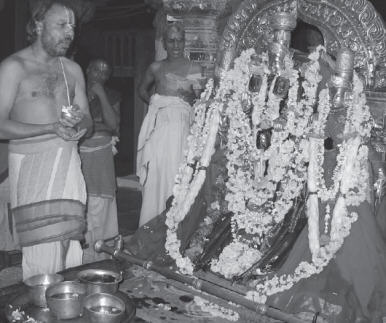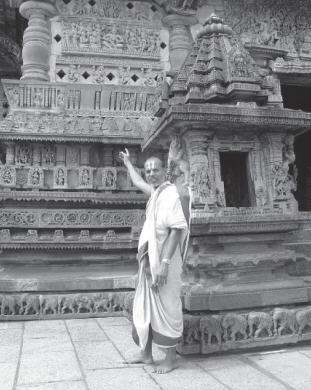At the heart of this exquisite display of classical Indian architecture lies a centuries-old tradition of deep devotion to the Deity.
Belur is a small town in southern Karnataka State. It became the capital of the Hoysala dynasty (A. D. 1000-1346) duting the reign of Bittideva (1108-1142), originally a follower of Jainism. Impressed and inspired by Ramanujacarya, he became a Vaisnava and accepted the name Visnuvardhana. In 1117 he began building the famous Chenna Kesava temple in Belur. The temple took 103 yeats to complete. Consideted a unique example of the Hoysala style of architecture, it attracts many tourists as well as pilgrims. (Chenna means "beautiful," and Kesava is a name for Krsna meaning "one with lovely long hair." I arrived in Belur during a nine-day religious festival (Navarattj). The whole town was decorated with lamps and flowers, and people were in a festive mood. At the Chenna KeSava remple, the utsava deiry (a small deity used for festivals) went out on a procession around the temple each evening. Accompanied by the sounds of trumpets and drums, priests invited the deity and then placed Him on a palanquin, carried by about a dozen people. Everyone followed the Lord as He traveled out of the temple to circle it and visit some neighboring areas. At the end of the procession, the deity arrived at a small open pavilion next to the temple compound, While some priests chanted mantras, others offered spiced rice, a flame (ghee lamp), fragrant mogra garlands, and water. When the ceremony was over, priests distributed prasadam to everyone. Then the Deity returned to the temple, and very soon the temple was closed.
For nine days Chenna Kesava rode on the palanquin in the evening and Laksmi, the consort of the Lord, went out in the morning. after the Laksmi procession the next morning, I approached Parthasarathi Bhattar, one of the main priests of the temple. He kindly took me to the small shrines of Ramanujacarya , Nrsimha, Krsna, and Sita-Rama-Laksmai-Hanuman in the temple compound. Then he showed me the Deities of Santi Narayarna, Sudevi (Saumyanayaki), Vira Narayarna, and Bhudevi (Raitganayaki). They are in beautiful small temples situated around the main temple. At each temple, he offered me caranamrta (water that has bathed the Deity), some tulasi leaves, a ghee lamp, and a red powder (kumkum). The Deity in the temple of Santi Narayana, which was built by Vishnuvardhana's queen Shantala Devi, is identical to Chenna Kesava but smaller. The temple is also similar to the main temple.
In the right corner of the compound, Parthasarathi Bhattar showed me a small pond called Vasudeva Tirtha and, extending along the inside of the compound wall, a row of cells fronted by a long pillared veranda that contains many sculptures and inscriptions in stone. The inscriptions record details of the construction of the temple, the artists employed, the grants and endowments given, and the renovations to the temple.
As special mercy, Parthasarathi Bhattar then took me to the inner shrine of the life-sized Chenna Kesava Deity. Most visitors can view the Deity only from the temple hall. The four-armed deity holds the disc and conch shell in His upper hands and the lotus and club in His lower ones.
A silver knife was on His belt. Parthasarathi Bhattar told me that the Deity is self-manifested. It is said that Lord Brahma had worshiped Him on Satyaloka. Later, King Indradyumna brought Him here and worshiped Him until his passing. The deity was then worshiped by the devas until the service was taken up by King Vishnuvardhana.
The story is that once, when the king was traveling in the Belur area, one of his servants, who had leprosy, was cured after bathing in the lake known as Visnu Samudra. Seeing this, the king thought that this must be a very sacred place, so he decided to build a temple. To confirm his decision, Sri Kesava simultaneously appeared in his dream and in the dream of Ramanujacarya and ordered them to build the temple for Him. As instructed in his dream, the king took several devotees to Chandra Drona Hill and discovered the Deity. He then took the Deity to Sri Narayanapura, and from there to Velapura (present-day Belur).
Parthasarathi Bhattar then introduced me to the history of the temple construction and details and stories of the sculptures. Some of hundreds of tourists who daily visit the temple joined us on a tour. Parthasarathi Bhattar explained that the one-hundred foot high entry gate was built in Dravidian style four hundred years later than the temple. Because the peak of the tower represents the horns of a cow, it is called a gopura (go means "cow," and pura means "city"). In front of the temple is a pillar and a Deity of the Lord's carrier, Garuda, standing with folded hands. The main structure of the temple is an architectural unit set upon a raised platform in the shape of a sixteen-pointed star.
As we came closer to the temple, Parthasarathi Bhattar pointed to a sculpture near the entrance depicting a man fighting a lion and told us how the Hoysala dynasty got its name. He said that this sculpture represents Sala, legendary head of Hoysala dynasty. The words hoy sala mean "Strike, Sala!" and were shouted out to the king when he was fighting a tiger. Sala immortalized himself and the tiger by single-handedly killing the beast, and his act of heroism inspired the royal emblem of the Hoysala dynasty. The rulers of this clan were called the Yadava kings, and they ruled with tremendous power. After defeating the Calukyas, they rose above all to become the paramount rulers in South India, even over the famed Cholas and Pandyas.
The temple hall has three majestic entrances, each with two flights of steps: one up to the platform and one up to the floor level of the hall. Flanking the steps are miniature shrines for Deities of different forms of Visnu, such as Narayana, Madhava, and Govinda. The elaborate nine-foot-tall doorways are each carved from a single piece of stone. The front one shows Lord Nrsimha in the center, wear through the dim light of a few ghee lamps. The forty-six pillars of various sizes, shapes, and designs show that King Vishnuvardhana wanted to build a temple surpassing all others. The most amazing pillar is the Nrsimha pillar. Lord Nrsimha was a family deity of the Hoysala dynasty. The pillar reveals the artists' special care, and once rotated on stone ball-bearings. Irs adornments include miniature sculptures of dancing goddesses, Visnu incarnations, Lord Siva, Ganesa , and Nandi (Siva's bull). In the middle of the pillar is the sculpture of Lord Nrsimha. A small space has been left unsculpted, a challenge to any artist to surpass the original. So far, no one has taken up the challenge.
Four central pillars support a domed ceiling made of seven interlocked pieces of stone. It is one of the most elaborately decorated ceilings in all of India. In the middle of the circular dome hangs a stone representing Lord Siva. Above that is a lotus, representing Lord Brahm. On the lotus sirs Lord Nrsimh a. The entire ceiling is spotlighted from the smooth circular floor, where dance and music are performed for the pleasure of Chenna Kesava.
WORSHIPING LAKSMI

Laksmidevi Temple
It took us all afternoon to examine most of the sculptures. In the evening Parthasarathi Bhattar invited me to his home to take part in the worship of Laksmi. Every evening of the Navaratri festival he would offer flowers, fruits, and a ghee lamp to Laksmi. On the last day he worshiped Lord Hayagriva, represented by books, for the blessing of knowledge and prossing an intestine garland while killing the demon Hiranyayakasipu . Miniature forms of the other prominent avatars of Visnu frame the sculpture. Below Nrsimha is Garuda, and on the sides are two Makaras, from whose mouths arches spring. Makaras are an aquatic species with a crocodile face, a monkey's eyes, a cow's ears, a lion's feet, an elephant's trunk, and a peacock's tail. On the left side of the wall is a bas- relief representing the meeting hall of King Vishnuvardhana. He is seated in the center, receiving instructions from his spiritual master Ramanujacarya. On the left side is Queen Shantala Devi.
Intricately carved horizontal friezes fill the surface of the temple exterior. The sculptors authentically executed stories from the Puranas , Upanisads, Mahabharata, and Ramayana. The lowest frieze is a series of 650 charging elephants, each one unique. They symbolize stability and strength and are considered the support of the temple. There is much symbolism in the carvings. Lions symbolize courage, horses symbolize speed, vines symbolize beauty-admirable qualities in a cultured society.
UNPARALLELED CRAFTSMANSHIP

After circling the temple and studying the remarkable artistic details of the sculptures on its walls, we entered the dark, mysterious interior, which shyly reveals its greatness perity. Many neighbors joined the celebration, singing devotional songs. During the festival, in every house people kept different kinds of dolls. Parthasarathi Bhattar had the ten incarnations of Lord Visnu, as well as dolls of devotees dancing, playing instruments , and carrying a Deity on a palanquin. There were many toy animals. Two dolls represented the king and queen. This exhibition of different objects and living entities symbolizes worship of the cosmic form of the Lord.
The next day was the final day of the fesrival, Vijaya Dasami. On this day Lord Rama killed Ravana after nine days of fighting. The anniversary of Madhvacarya's birth falls on the same day. So early in the morning I visited Raghavendra Swami Matha, where devotees in the Madhva line worship deities of Laksmi-Nrsimha and Hanuman.
Later, Parthasarathi Bhattar took me to the lake Visnu Samudra on the outskirts of the town. It is said that the lake appeared from a drop of nectar that fell from Ga ruda's pot, and that the king of the ocean resides here on the order of Lord Parasurama. This is the lake in which King Vishnuvardhana's servant was cured of leprosy.
PROCESSION TO THE SAMI TREE
In the late afternoon the celebration of Vijaya Dasami began by bringing the festival Deity of Chenna Kesava to the courtyard. For the procession, the Deity rode on a metal, gold-painted horse, set on a trailer pulled by a tractor. Priests of the temple and priests from the Madhva line decorated the Deity and the tractor with garlands of flowers and leaves. Musicians playing trumpets and drums led the procession. Many people followed, offering items and prayers. The Deity went down main street, filled with many restaurants and shops, past the bus station , over the Badari River, and proceeded four kilometers to a stone pavilion at the edge of town.
Many people gathered there. Leaving the Deity, the priests walked to a nearby Sami tree. The Mahabharata states that on Vijaya Dasami day Arjuna retrieved the weapons he had hidden in a Sami tree and went to fight with the Kauravas, who were stealing King Virata's cattle. One of the priests took the Deity's sword and cut some Sami leaves to signify Arjuna's retrieving his weapons. Another priest offered the leaves to the Deity, who represents the king. This ceremony celebrates the king's victory over evil and his bringing peace to the citizens.
King Vishnuvardhana wanted to build a magnificent temple for Lord Visnu in Belur, and the extraordinary Hoysala builders and artists developed a new style of temple architecture to fulfill his desire. By offering their skills to the Supreme Person, they attained perfection, creating highly expressive sculptures that almost seem alive.
